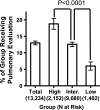Obstructive airways disease with air trapping among firefighters exposed to World Trade Center dust
- PMID: 19820077
- PMCID: PMC2832867
- DOI: 10.1378/chest.09-1580
Obstructive airways disease with air trapping among firefighters exposed to World Trade Center dust
Abstract
Background: The World Trade Center (WTC) collapse produced a massive exposure to respirable particulates in New York City Fire Department (FDNY) rescue workers. This group had spirometry examinations pre-September 11, 2001, and post-September 11, 2001, demonstrating declines in lung function with parallel declines in FEV(1) and FVC. To date, the underlying pathophysiologic cause for this has been open to question.
Methods: Of 13,234 participants in the FDNY-WTC Monitoring Program, 1,720 (13%) were referred for pulmonary subspecialty evaluation at a single institution. Evaluation included 919 full pulmonary function tests, 1,219 methacholine challenge tests, and 982 high-resolution chest CT scans.
Results: At pulmonary evaluation (median 34 months post-September 11, 2001), median values were FEV(1) 93% predicted (interquartile range [IQR], 83%-101%), FVC 98% predicted (IQR, 89%-106%), and FEV(1)/FVC 0.78 (IQR, 0.72-0.82). The residual volume (RV) was 123% predicted (IQR, 106%-147%) with nearly all participants having normal total lung capacity, functional residual capacity, and diffusing capacity of carbon monoxide. Also, 1,051/1,720 (59%) had obstructive airways disease based on at least one of the following: FEV(1)/FVC, bronchodilator responsiveness, hyperreactivity, or elevated RV. After adjusting for age, gender, race, height and weight, and tobacco use, the decline in FEV(1) post-September 11, 2001, was significantly correlated with increased RV percent predicted (P < .0001), increased bronchodilator responsiveness (P < .0001), and increased hyperreactivity (P = .0056). CT scans demonstrated bronchial wall thickening that was significantly associated with the decline in FEV(1) post-September 11, 2001 (P = .024), increases in hyperreactivity (P < .0001), and increases in RV (P < .0001). Few had evidence for interstitial disease.
Conclusions: Airways obstruction was the predominant physiologic finding underlying the reduction in lung function post-September 11, 2001, in FDNY WTC rescue workers presenting for pulmonary evaluation.
Figures




References
-
- Prezant DJ, Weiden M, Banauch GI, et al. Cough and bronchial responsiveness in firefighters at the World Trade Center site. N Engl J Med. 2002;347(11):806–815. - PubMed
-
- Feldman DM, Baron SL, Bernard BP, et al. Symptoms, respirator use, and pulmonary function changes among New York City firefighters responding to the World Trade Center disaster. Chest. 2004;125(4):1256–1264. - PubMed
-
- Banauch GI, Dhala A, Alleyne D, et al. Bronchial hyperreactivity and other inhalation lung injuries in rescue/recovery workers after the World Trade Center collapse. Crit Care Med. 2005;33(1 Suppl):S102–S106. - PubMed
Publication types
MeSH terms
Grants and funding
- U10 OH008243/OH/NIOSH CDC HHS/United States
- K24A1080298/PHS HHS/International
- U10 OH008242/OH/NIOSH CDC HHS/United States
- R01HL057879/HL/NHLBI NIH HHS/United States
- M01 00096/PHS HHS/International
- K23HL084191/HL/NHLBI NIH HHS/United States
- U10-OH008242/OH/NIOSH CDC HHS/United States
- R01-OH07350/OH/NIOSH CDC HHS/United States
- U10-OH008243/OH/NIOSH CDC HHS/United States
- K23 HL084191/HL/NHLBI NIH HHS/United States
- R01 HL057879/HL/NHLBI NIH HHS/United States
- U1Q/CCU221158/PHS HHS/International
- T32 ES007267/ES/NIEHS NIH HHS/United States
LinkOut - more resources
Full Text Sources
Medical

